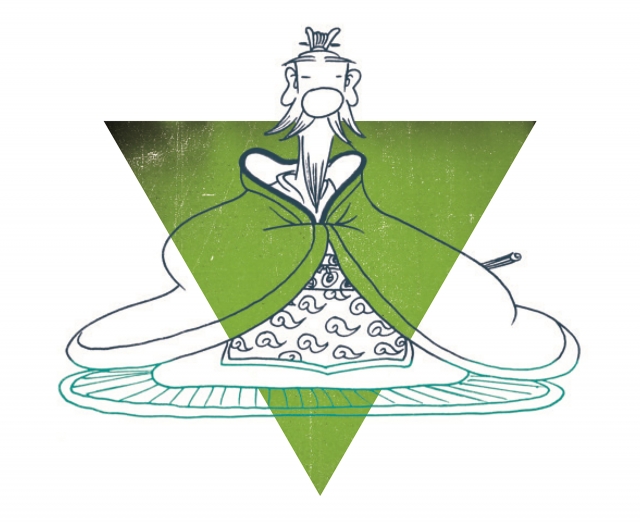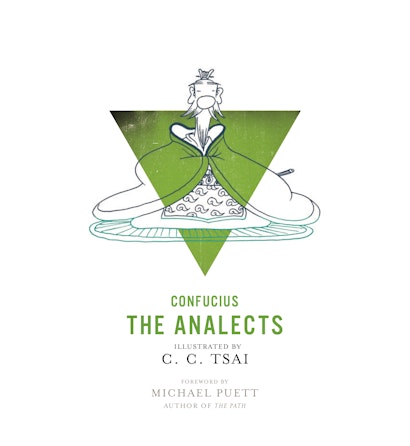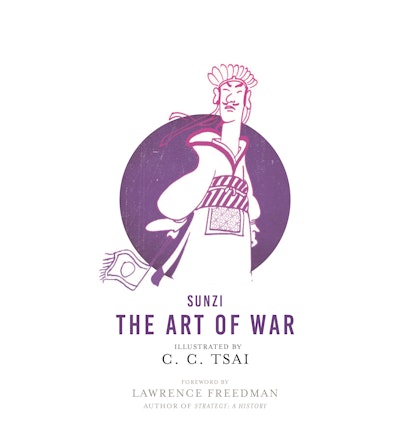C. C. Tsai is one of Asia’s most popular cartoonists, and his editions of the Chinese classics have sold more than 40 million copies in over twenty languages. These volumes present Tsai’s delightful graphic adaptation of The Analects and The Art of War, two of the most influential books of all time and works that continues to inspire countless readers today. The texts are skillfully translated by Brian Bruya, who also provides an introduction.
What got you interested in illustrating the Chinese classics?
CCT: Ever since I was small, I loved reading—the Bible, detective stories, world classics, science. Of course, the Chinese classics were also part of the mix. In 1985, I moved to Japan to hide away and draw something new. This was a time when teenage love stories were all the rage in Japan. It occurred to me that I could use the simple-to-understand form of the comic to express difficult-to-understand ancient classics. I started with the charming stories of Zhuangzi.
How were these different from what you’d been drawing all along? And what did you hope to get across to your readers?
CCT: Before these books, I did mostly comic strips, and in those, I did all the creative work, including the story lines. With the classics, I am illustrating the works of thinkers like Laozi, Zhuangzi, and Mencius. It still required quite a bit of creativity to distill the works into digestible episodes, but it also required an enormous amount of background reading and research. My aim was to put the essence of their thinking into pictures.
I’ve heard that you have unique working habits—that you go to bed at 5 p.m., get up at 1:00 a.m., and work until 2:00 p.m. When did you start this routine, and why?
CCT: My lifestyle resembles that of the great French writer Balzac: to bed at dusk and up at about 1:00 a.m. Then, stand in the window drinking coffee and thinking. 95% of my thinking at this time is about the future. Only 5% is about the past. Then I start working and work straight through until about 2:00. Then, I eat, take a nap, and either read or watch a movie on the internet. When you really focus on one thing, there is nothing but silence, and it’s as if you are the only thing that exists in the whole world. It’s as if time slows to a halt. This is why I prefer to get up in the night to welcome each new day. From my experience, the stomach and brain are in a reciprocal relationship. Creativity is highest when the stomach is empty. And when the stomach is full, the brain turns off. I don’t really like to eat and prefer not to interrupt my work with meals. After eating, I can never get back to the same state of creativity.
You’ve done so many amazing things in your life. What are you the most proud of?
CCT: The thing that I am the most proud of is using maximal freedom to live the simplest life. I took ten years off just to study physics. Those were the ten happiest years of my life. Second to that was the four years that I spent in Japan while drawing the Chinese classics. If you can do what you most love over an extended period of time—that is a life worth living!
Of all the comic books you’ve created, which is your favorite?
CCT: The sage Laozi is my idol, but Zhuangzi must have been my form in a previous lifetime. I’m most like Zhuangzi, and I like Zhuangzi the most. He was blind to fame and fortune and simply lived his own life without concern for what others thought. I do the same, and this is why I drew Zhuangzi first in the series.
Are you one of those old guys trying to bring back traditional culture? Doesn’t it seem out of touch with today’s youth, who prefer surfing the Internet, getting on social media, and figuring out ways to make a quick buck?
CCT: There is nothing wrong with getting online or wanting to make a quick buck. The question is: how many people succeed in making that quick buck? Maybe one in a thousand, or one in ten thousand. I have always lived by three simple principles:
- Find something you are good at and that you like to do and then devote yourself to it.
- Once you get good at something, your efficiency will increase exponentially, and you’ll be faster than you ever expected. This builds on itself, so that you increasingly get faster and better.
- When you can perform efficiently and at a high level, you’ll have very little competition. Challenge yourself. Every time you do something, try your best to do it faster and better than you did it last time. Soon, you will speed right past all of your peers.
You began drawing when you were 4 years-old. Do you remember your first drawing?
CCT: I have a deep impression of my first work of art. When I was two years-old, I was awe-struck by the special red ink that my dad would sometimes use in his calligraphy, so when he wasn’t looking, I grabbed his brush and used that red ink to draw the shape of a person on our white wall. The subsequent punishment is what made it stick in my memory.
Have you ever altered your style to meet the demands of your readers, or of the market?
CCT: In the fifty years that I’ve been drawing comics, including 7 years doing animation, I’ve developed 20 different styles. I tailor the style to the content. For traditional philosophy, I balance the difficulty of the thought with a light and breezy drawing style. But this is in service to the reader. I always have the needs of the reader at the front of my mind. Do these sections flow together? Is this sentence clear? A book is a way to connect with a reader’s mind. From creation, to editing, to printing, to distribution—a book is not complete until the reader has finished reading.
What is the focus of your work now? Do you have any plans for a new series?
CCT: I just finished a series on Buddhism, along with two animated feature films, and am now planning a series on the “wisdom of the East.”
What other kind of challenges do you plan to take on?
CCT: I have a strong interest in creating a comic book series devoted to helping people understand physics and mathematics. I’ve been studying these subjects for many years and am just about ready. At this point in my life, though, it becomes a matter of whether I am still alive and have the energy to complete the project.
Has drawing comics always been your goal in life?
CCT: Drawing comics is not my goal in life. My goal is to live with as much spiritual freedom as possible and as few material desires as possible. There is a story of a little chick that has just pecked its way out of its shell when it comes across a snail. “So that’s what a shell is for,” it says to itself. So the chick picks up the pieces of its shell and carries them on its back for the rest of its life. We are born free, so why accumulate shells to carry on your back? Our purpose in life is not to accumulate fame and fortune that we can’t take with us when we die; it is to be who we are to the fullest extent possible. Since we only have one life to live, we have to make the most of it. That’s why I’m not willing to spend an ounce of energy pursuing fame or fortune. Look at your life from the perspective of your death, then go and do something significant.
What books have influenced you the most?
CCT: I’ve found that reading is the most rewarding investment of one’s time. By the time I was three, I had finished reading the Bible. At 9, I had read many of the world’s most famous works of literature. Up to now, I’ve probably read over twenty thousand books, including eight thousand comic books. Of these, my favorite author is Kahlil Gibran. My favorite books are Gibran’s The Prophet and Sand and Foam and Lewis Thomas’ Lives of a Cell.
From your own experience and perspective, to what do you attribute your success. What could your fans learn from you about how to succeed in their own lives?
CCT: A person without a dream is like a butterfly without wings. In Taiwan, there is a saying: a blade of grass, a drop of dew. In the early morning, every kind of plant, whether big or small, a weed or a flower, will have dew on it. What this means is that nature is fundamentally fair, in that everyone has their own talents and abilities. You just have to develop them.
You have popularized comic books about ancient times. Do you feel like you have some special connection with the ancients?
CCT: I am interested in anything that has to do with wisdom. Reading is like being a neighbor to the ancients, like forming a friendship with them. I have never traveled for the sake of traveling, like a tourist does. Instead, I travel with the people of the past.
Where do you find your inspiration?
CCT: My inspiration comes from my attempt to connect with wisdom. I try to use this creative form to pass on some wisdom to later generations. My process lies in reading and note-taking. I’m slow at reading paper books and now prefer to read books on the computer. I download some ancient book, convert it to a Word document, and add correct punctuation. It’s hard on my eyes, and I sometimes think I’ll go blind doing it like this. Is this a bottleneck in my workflow? Actually, no. If I were to convert all of my notes to paper notebooks, I estimate they would take up something like 800 volumes.
Whenever people achieve a level of great success, it’s natural that others wonder how they were able to do it. What would you say is the secret to your success?
CCT: The secret to success is to find something you love and then do it. Even today, I still love to work. I work 16 – 18 hours per day. I don’t have a cell phone, and still use a land line. I also don’t have material desires to speak of, getting by on about $8/day. Besides working, my next love is playing bridge online. I’m still that little kid from the Taiwan countryside—very simple, just doing whatever he enjoys the most.
When did you first think of putting ancient thought into comics? Did your understanding of it come through studying it on your own?
CCT: When I was 9 years-old, I realized that if you really want to learn something, you have to teach yourself. The questions are yours, and you have to come up with the answers. Most teachers are just average people and are limited in their ability to satisfy a child’s curiosity. It was then that I began my project of self-learning. Self-learning is how you learn fast and efficiently. Everything I know, I’ve learned this way: cartooning, animations, physics, advanced mathematics, Japanese, bridge, Asian philosophy, Buddhism, Zen, and so on. I’m an autodidact through and through. When I was 36 years old, I had the idea that putting classical literature into comics could be of great benefit to others. So, I decided to go to Japan and spend four years creating this series. Wouldn’t it be great to take priceless ideas of the Chinese classics and transmit them via the most efficient modern media format? Nothing could be more natural!
Who has most influenced your drawing style?
CCT: I was exposed to the Bible when I was just one year-old. When I was 3-and-half, I began thinking about what I wanted to do with my life. When I was four-and-a-half, I decided that I would become an illustrator. At 9, I set my mind on becoming a professional cartoonist. I published my first comic when I was 15. When I first started drawing comics, I was heavily influenced by my idol at the time, Tetsuya Chiba. But after a year, I found my own voice and developed my own style. At 36, when I was traveling through the Kuala Lumpur airport, I came across some comics by a cartoonist who goes by the name of Lat. There is a freedom to his drawings that helped me develop my carefree style. But the one thing that has been most influential in my drawing has been my own studies—of classical Chinese painting, Western art history, Bauhaus design, not to mention physics and mathematics. It was only after studying formulas in physics and math that my drawing took on a kind of lyrical openness. But I don’t have just one style. Right now, I can draw in any of 20 different styles. It’s not a problem if a beginning artist is influenced by an idol’s style, but the artist has to very quickly transition to a unique style. We’re each a unique being from the day we’re born. If we can’t be ourselves, who is going to come and be us? We are our own selves, not copycats of others.
C. C. Tsai is one of East Asia’s most popular illustrators. His bestselling editions of the Chinese classics have introduced generations of readers to the wisdom of such luminaries as Zhuangzi, Sunzi, and Laozi. Born in Taiwan, Tsai now lives in Hangzhou, China.


